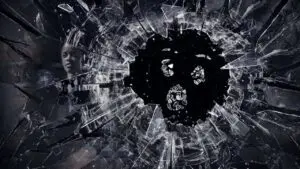Summary
“Demon 79” revels in its Red Mirror label, abandoning the usual dystopian technophobia in favour of straightforward supernatural horror, but all the elements it leaves behind are those most integral to Black Mirror’s appeal.
This recap and review of Black Mirror Season 6 Episode 5, “Demon 79”, contains spoilers.
Black Mirror as an anthology has always playfully experimented with genre and tone, but the title is ultimately synonymous with a specific kind of dystopian future and media satirization. When people think of it, they think of something like the Emmy-winning “San Junipero”, “The Entire History of You”, or that creepy Miley Cyrus doll in “Rachel, Jack and Ashley Too”.
The marketing for Black Mirror Season 6 has hinted at redefining the terms of what an episode of the show is, what it can mean and to whom, and the “Red Mirror” moniker that defines the final episode of this season, “Demon 79”, seems to be what was being hinted at.
Why is “Demon 79” a Red Mirror episode?
While the Red Mirror label doesn’t have a concrete definition, it’s easy to intuit. “Demon 79” isn’t set in the future, doesn’t involve the media, and contains virtually no tech. Instead, it’s a period supernatural horror.
Setting this episode apart from the others is obviously deliberately drawing attention to how it departs from the usual formula. That makes it intriguing as a Black Mirror outing, even if it isn’t all that interesting on its own terms, playing out like a straightforward shocker with a dark comic undertone and a familiar sense of ambiguity around whether the protagonist is insane.
Black Mirror Season 6 Episode 5, “Demon 79” Recap
That protagonist is Nida (Anjana Vasan), a mild-mannered retail assistant in a late-70s England awash with racial panic, political upheaval, and a looming Cold War. Loki and Ms Marvel writer Bisha K Ali (who also executive produced the first episode in this season, “Joan Is Awful”) seems to have had much more of a say than her co-scribe, Charlie Brooker himself, in depicting the various injustices and micro-aggressions that Nida is subjected to in her day-to-day life.
Brooker’s influence creeps through in the episode’s hook, which finds Nida stumbling on a talisman featuring the series’ trademark White Bear symbol. She spills some of her blood on it, bringing forth a demon named Gaap, who takes the amenable form of Paapa Essiedu cosplaying Bobby Farrell from Boney M.
Gaap explains to Nida that she must make three sacrifices – read: commit three murders – ahead of May Day to avert a nuclear apocalypse and prevent Gaap from being banished to an unknowable cosmic nothingness.
Nida is a good mark since she was already fantasizing about the violent deaths of her colleagues before the demon got involved. Progressing to actually killing them seems a fairly small affair, especially since most seem to deserve it.
Nida’s ensuing killing spree is continually justified by Gaap, who can show Nida the secret lives and potential futures of her would-be victims – a man by a canal who abuses his daughter, a creep in a pub who murdered his wife.
While Nida struggles with beating people over the head with a hammer, she quickly gets used to the idea. When she meets Michael Smart, a racist Conservative parliamentary candidate whose future holds a fascistic stint in Number 10, she selects him as her third and final victim, despite Satan and his acolytes being “fans of his work”.
Nida attempts to kill Smart but is apprehended in the process. As the clock ticks to midnight, she’s apologetic about not having been able to avert the coming apocalypse.
Is Gaap real or imagined?
I know what you’re thinking – Nida is just nuts. And there’s certainly evidence to support this theory.
After Nida is arrested, the talisman presents as a simple domino. The implication is that it might have always been one, and Nida was simply imagining her justification for going postal.
However, the episode’s climax seems to suggest otherwise.
Black Mirror Season 6 Episode 5 Ending Explained
At the end of “Demon 79”, the clock hits midnight, and soon after the nuclear war begins.
This means everything Gaap was saying was true. Or, at least, it implies it was. There’s still a chance that Nida could have been imagining the apocalypse itself, but that seems a stretch given how many other characters openly react to it.
Gaap presents himself once again to a devastated Nida. Since they have both failed in their missions, he proposes that they leave for damnation together. And they do, hand in hand, while the world around them burns.
Black Mirror Season 6 Episode 5, “Demon 79” Review
In reinventing itself as a straightforward supernatural horror, “Demon 79” abandons some of Black Mirror’s trademark technophobia, cynicism, and nihilism, though forgets that those things are largely what make the show stand out.
Without these elements “Demon 79” relies on a well-observed northern English conservatism and some considerable wit, with Gaap being a consistently – if bleakly – funny presence. But its well-trodden “is she nuts?” ambiguity and tame horror do little to elevate it above the standard of workmanlike genre fiction – a disappointingly timid takeaway for an episode of Black Mirror.
You can stream Black Mirror Season 6 Episode 5, “Demon 79”, exclusively on Netflix.




